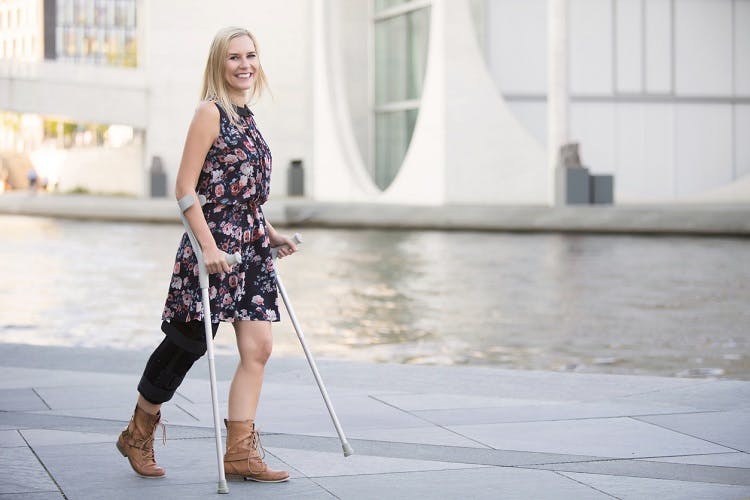Cerebral palsy can affect motor control anywhere in the body, including the legs. When cerebral palsy affects the lower extremities, it can cause motor impairments in one or both legs. This can impact the way individuals walk and perform self-care activities.
To help you understand what to expect when cerebral palsy affects the legs, this article will address:
- What causes motor impairments in the legs?
- How cerebral palsy may affect the legs
- How to manage cerebral palsy that affects the legs
- An inspirational story about overcoming lower extremity motor impairments
What Causes Motor Impairments in the Legs?
Cerebral palsy is a developmental motor disorder caused by damage to the brain before, during, or shortly after birth. It is most commonly caused by damage to the motor cortex, which is the part of the brain responsible for regulating voluntary movement.
When the region of the motor cortex responsible for leg movement is damaged, individuals with cerebral palsy experience motor impairments in the legs. Depending on the severity of that damage, motor impairments in the legs can range from mild to severe and affect one or both legs.
When cerebral palsy primarily affects the legs, it is called spastic diplegia. In contrast, when only one side of the body is affected, it is called spastic hemiplegia. Motor impairments throughout the entire body are referred to as spastic quadriplegia.
Because everyone experiences cerebral palsy differently, motor impairments can vary significantly. For example, an individual with more severe cerebral palsy may not be able to stand or walk while someone with mild CP may only demonstrate a slightly irregular gait or walking pattern.
In the following section, we’ll discuss various ways motor impairments in the legs can affect everyday life.
How Cerebral Palsy May Affect the Legs
When motor impairments caused by cerebral palsy affect the legs, various functions can be impacted.
Most commonly, individuals may develop an abnormal gait. In those with spastic cerebral palsy, irregular walking patterns are caused by involuntary muscle contractions called spasticity. Spasticity occurs because communication between the brain and muscles is disrupted.
When the muscles in the legs experience spasticity, they tighten and range of motion becomes limited. As a result, individuals develop an abnormal gait.
Common gait patterns demonstrated by individuals with spasticity in the legs include:
- Toe walking
- In-toeing
- Out-toeing
- Crouch gait (when the ankles, knees, and hips remain continuously bent)
- Scissor gait (when the knees touch or cross over one another while the feet are spread apart)
The type of gait pattern someone has is determined by which muscles are affected by spasticity. For example, tight calf muscles will pull the heels up and force people to walk on their toes.
Other potential outcomes of motor impairments in the legs include:
- Poor balance and coordination
- Slow movements
- Increased risk of falling
- Chronic pain
- Sleep problems
- Hip dislocation
- Poor bowel and bladder control
Up next, we’ll discuss effective ways to manage motor impairments in the legs to reduce the risk of severe complications.
Want 19 pages of CP recovery tips in PDF form? Click here to download our free illustrated ebook now (link opens a pop up for uninterrupted reading)
How to Manage Cerebral Palsy That Affects the Legs

Although the brain damage that caused cerebral palsy is irreversible, the impact of its secondary effects can be significantly reduced when managed appropriately.
Additionally, the brain is extremely adaptive and can reorganize its neural circuitry by utilizing neuroplasticity. Neuroplasticity is the brain’s ability to rewire itself, meaning that functions affected by cerebral palsy can be reorganized to healthier, undamaged parts of the brain and improved.
The best way to activate neuroplasticity is through massed practice. The more repetitions of an exercise or activity you perform, the stronger the rewired neural pathways become. Many individuals with motor impairments in the legs learn how to effectively reduce their spasticity and boost leg mobility by promoting neuroplasticity.
Below, we’ll discuss several interventions that may be involved in managing motor impairments in the legs.
Physical Therapy
Physical therapy plays an essential role in the management of motor impairments. One of the main goals of physical therapy is to promote neuroplasticity through exercises designed to improve gait, relieve spasticity, promote proper posture and positioning, strengthen underused muscles, and improve range of motion.
A physical therapist will assess which muscles need to be targeted and develop a personalized exercise regimen. While you learn how to perform the exercises in physical therapy, it’s also very important to practice them at home on your own time to get the repetitions necessary to strengthen neural pathways in the brain.
Occupational Therapy
Occupational therapy helps individuals learn effective ways to be independent, primarily by focusing on everyday activities.
Even with severely affected legs, many people with cerebral palsy learn to be functionally independent by learning alternative ways to make up for impaired motor control called compensatory strategies. As a result, many individuals learn to maintain a job, play adaptive sports, use adaptive tools, drive a car with modified controls, and perform many activities of daily living all on their own.
Developing a strong sense of independence can help individuals with CP feel more confident in their bodies and abilities.
Orthotics
Orthotic devices such as braces, splints, and casts provide structural support, which can help individuals with cerebral palsy improve their form. They help hold the limb in place and promote musculoskeletal alignment so individuals can walk more naturally.
Additionally, orthotics can help mildly stretch spastic muscles and prevent them from further tightening.
A physical therapist can recommend an orthotic that is appropriate for you.
Medications
Botox and baclofen are medications that can temporarily reduce spasticity in the legs.
Botox works by blocking the chemical signals that cause muscle contractions. It is directly injected into tight muscles and can relieve spasticity for several months. In contrast, baclofen is a muscle relaxant that can be taken orally or injected into the spinal canal via a baclofen pump.
The most effective way to improve long-term motor control is to take advantage of reduced spasticity from medications and intensively work on physical therapy exercises. This will help boost mobility and promote neuroplasticity for benefits that will last even after the effects of the medication wear off.
Surgical Interventions
Surgery is generally only recommended when all other interventions fail to reduce spasticity in the legs.
Muscle lengthening surgeries (typically of the heel cords or hamstrings) will manually lengthen contracted muscles.
Another surgery that may be recommended for severe spasticity is selective dorsal rhizotomy. It involves selectively cutting the nerve roots to reduce hyperactive muscle contractions.
Achieving Goals with Cerebral Palsy That Affects the Legs
Although cerebral palsy in the legs can present challenges with walking and daily activities, individuals can still be very functional and successful in reaching their goals. To prove our point, we’d like to share Justin’s story as the first athlete with cerebral palsy to be signed by Nike.
On Instagram, Justin wrote:
“Growing up with a disability, the thought of becoming a professional athlete is as I have said before like the thought of climbing Mt. Everest! It is definitely possible, but the odds are most definitely not in your favor! […] I was once a kid in leg braces who could barely put on[e] foot in front of the other! Now I have signed a contract with Nike Running!”
Justin proves that having the resilience and determination to focus on your abilities, create a goal, and work towards it can pay off.
Cerebral Palsy and Leg Function: Key Points
Damage to the developing brain can cause cerebral palsy, which can result in motor impairments in one or both legs.
High muscle tone in the legs can pull the joints into specific positions and restrict range of motion. As a result, individuals with cerebral palsy that affects the legs often walk with an abnormal gait and may have difficulties with performing daily activities.
Fortunately, there are ways to reduce high muscle tone and train the brain to adapt to promote long-term relief. We hope this article helped you understand the implications of motor impairments in the legs and how to potentially improve them.











